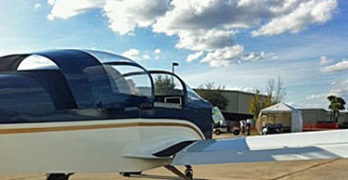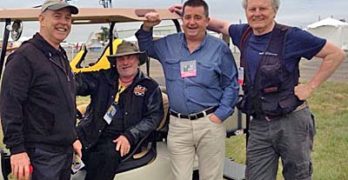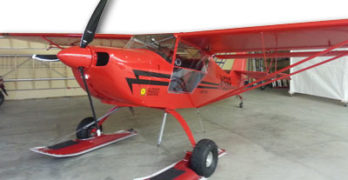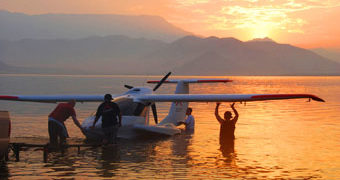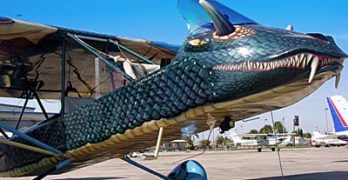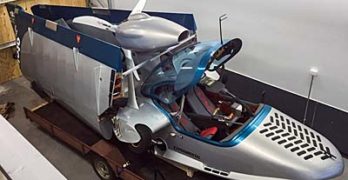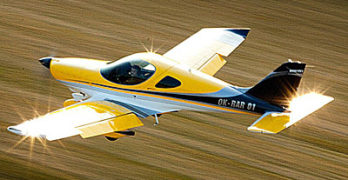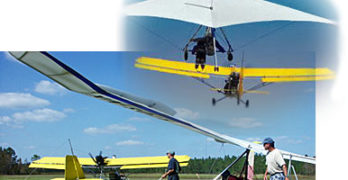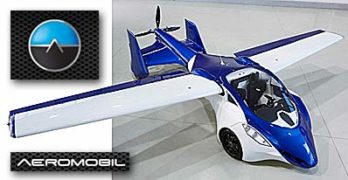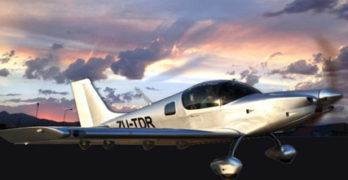If you are not an iPad user — like I am along with millions of others including a significant number of pilots — perhaps you just don’t care about iPads in the cockpit. This isn’t an Apple ad; they hardly need any more promotion. Yet iPads in the cockpit can do some great work for a much lower cost than anyone would have imagined less than five years ago (iPad was introduced in fall 2010).
Unless you have ignored the news since 2010, you are surely aware iPads can run slick apps like Garmin Pilot or Jeppesen’s Mobile FliteDeck VFR, WingX Pro, Foreflight, FlyQ, and several others. Most of these are very useful products and even with data subscriptions they don’t cost much. However, they all share one problem … a rather big one.
Simply, cockpits weren’t designed around the new technology.
You have to hold an iPad. Of course, several companies have made mounts of various types, some of which hang out from the instrument panel and swivel about like a wall-mounted TV so you can poke and prod them while flying.
Search Results for : Flight Design
Not finding exactly what you expected? Try our advanced search option.
Select a manufacturer to go straight to all our content about that manufacturer.
Select an aircraft model to go straight to all our content about that model.
Boeing & Airbus Explore Light Aircraft
Recently I had a visit from my longtime friend and fellow aviation journalist, James Lawrence (photo). Among other mutual interests we share a passion for electric aircraft. We’ve each flown early examples and believe we see the future. From the headline above, you might interpret that to mean we anticipate electric airliners. We might … yet we recognize such developments remain distant. Or, do they?
The electric power action today is in very light aircraft — and some are available for you to buy and fly immediately. One example is Zigolo and I’ve reported on eSpyder. The reason is that light aircraft rule is singular: batteries, which weigh too much to allow heavier aircraft any range. The ending video explains why.
Unless you’ve been off-planet for a while, you know the development of improved battery technology is drawing many billions of dollars of investment. Cars, laptops, drones and many more products or industries want better batteries.
7 Aircraft to Look for at Sebring 2015
We’re off to the races … OK, the race track … OK, we’re off to Sebring, which happens to be alongside the Sebring International Raceway. Yep. It’s January so it’s again time for the Sebring Expo, this time number 11, the 2015 edition of the popular Florida show. I’ll be onsite for the four days, which this year is one day sooner, running Wednesday through Saturday. The plan makes it easier for vendors to stay to the end on Saturday and still have time to get home on Sunday so they can be back in their businesses on Monday.
Every time I head to a show people contact me, including journalists from publications that don’t follow Light-Sport, light kits, ultralights, or light GA as closely as we do). The question is always the same. What new aircraft or products will we see at the show? …Uh, let me think.
It’s Winter, So Seaplanes Are Flying … Uh, What?
On this website, we zoom around the world following Light-Sport Aircraft, from near the Arctic Circle — you know, where Santa and the wee elves are pulling some heavy overtime about now — to the warm balminess of Southern California. I know of what I write, having once lived in the snow belt and now hanging with the family in Palm Springs, California for Christmas. It seems everywhere I look I see LSA seaplanes in sea trials and this is happening in the dead of winter.
Why be surprised? Perhaps you’ve noticed boat shows happen in the winter months. When living in Minnesota, I was always amazed that boat shows were held in January and February, a time of year when it would be months before the ice melted from the state’s 10,000 lakes to allow use of those boats. Yet this is when people were shopping, I suppose anticipating an upcoming season of boating fun.
Fun, Powerful, Gnarly … that’s AirCam
What would you like for a Christmas present, perhaps if you won big in a lottery? Well, you’re a pilot so I might guess that some airplane has caught your fancy. Me, too. Like most pilots a number of desirable airplanes catch my eye but also like most pilots, I cannot afford to have one of each that appeals to me. High on my list of wished-for airplanes is Lockwood Aircraft‘s Air Cam. I have quite a few hours flying one example or another. I even earned my multiengine rating in one, as part of an article I wrote years ago.
As part of the required hours of training to take the flight check — no written test is involved for a multiengine rating — I engaged an old friend and multiengine instructor, Richard Johnson. An Air Cam owner, Sebring dentist Ron Owen, graciously supplied his Air Cam.
Finland’s Atol Amphib Begins Water Tests
Ah, the Christmas season is soon upon us (or already is judging by familiar music playing on every speaker you hear). It sounds like a great time to go put your new seaplane in the water … especially if you live up by the Santa Claus toy workshop. Wait a minute! Can that be right? Yup! Atol Avion Ltd., recently notified us, “We have finally performed first water taxi tests of our production prototype on December 14th, 2014 at Rovaniemi, Finland. After thorough systems tests, water taxi tests were performed on Kemijoki River near the Arctic Circle … just a few miles from Santa’s home. Our plane worked as planned and proved to be even better than expected.”
As a Florida resident, I have plenty of local acquaintances that think such an exercise sounds crazy, to be out water testing an amphibious airplane in winter. They mean here in Florida where it’s on the cool side … you know, 50s and 60s.
BRM Aero’s Bristell Gains New U.S. Distributor
BRM Aero‘s Bristell got off to a good start in the USA two years ago. Unfortunately, after an initial burst of positive reviews and good response from pilots, the distributor at the time stumbled. A failed association with the now-defunct Aviation Access Project undermined the efforts but that association had nothing to do with the Czech aircraft producer. So, after a year or so of discussions and evaluation, BRM Aero found a new, high-quality representative.
In early December 2014, Bristell Aircraft, a New York corporation, officially accepted the appointment to represent the aircraft of BRM Aero. “Bristell Aircraft is an American company whose roots go deep into the highly-structured world of FAA-certified aircraft,” said Lou Mancuso, director of Bristell Aircraft. Over the last year, Lou has worked directly with BRM Aero “to develop, customize, and standardize aircraft specifically for the North American market.” Lou and his team bring 68 years of aviation sales, service and training success and appear well suited to the endeavor.
Working Aircraft … for the Fun of Flying
In two industry meetings held during 2014, Light-Sport Aircraft manufacturers, organization leaders, FAA personnel, and other interested parties reviewed a list of changes that would improve the 10-year-old SP/LSA regulation. Some items represent minor changes the agency could make fairly quickly. Others are more challenging. Number one on the list involves FAA allowing certain commercial LSA operations when flown by qualified pilots. Even if no great resistance exists — and reasons for optimism are present — this could be some time coming as regulation change is complicated in today’s federal government. Another area of intense interest is electric power. While unleashing development of LSA using electric propulsion also requires regulation change, an exemption might allow technical progress before rule change could occur. Recently another group with many more years of effort already invested was able to earn such an exemption. Ed Pitman of Pitman Air recently announced Exemption 11104.
Aeromobil, Now at Version 3.0, Nears Production
I have reported on Aeromobil before and we’ve tried to keep up with those MIT geniuses at Terrafugia and their Transition that basically reinvigorated the flying car or (as Terrafugia prefers) roadable airplane. However, saying Terrafugia reinvented the flying car is hardly fair to other producers, in this case Slovakia’s Stefan Klein. At the Pioneers Festival — an entrepreneurship and future tech event held in Vienna, Austria at the end of October 2014 — Klein and his financial associate Juraj Vaculik unveiled their latest iteration of Aeromobil, specifically model 3.0. Beside a public showing, he demonstrated its flight capabilities to the public for the first time. Think what you will of Aeromobil or Transition, or for that matter, Maverick, but these ventures continue to attract attention and sufficient funding that it’s likely we’ll see some in the sky one day.
LSA Taildraggers Broaden the Sector’s Appeal
Taildraggers may be among the least understood and most feared aircraft available in the LSA space … or for that matter throughout general aviation. While we have many good choices that I’ll list below, I have nonetheless heard from many readers or airshow visitors that they are uncertain about their operation of an aircraft that has no nosewheel. If you have no taildragger skills, you’ll also find it a challenge to get proper flight instruction in a “standard” aircraft. For those seeking new skills in flying, however, taildraggers may provide high satisfaction. Most who have crossed the barrier to taildragging subsequently look very fondly at such aircraft, seeing a sleeker yet gutsier, more rugged appearance. Of course, nosewheels dominate general aviation as they can be easier to land, especially in crosswinds, but once you learn the lesson of “happy feet” — or keeping your feet active on the rudder pedals throughout approach and touchdown — you may always yearn for more taildragger time.
- « Previous Page
- 1
- …
- 84
- 85
- 86
- 87
- 88
- …
- 147
- Next Page »


